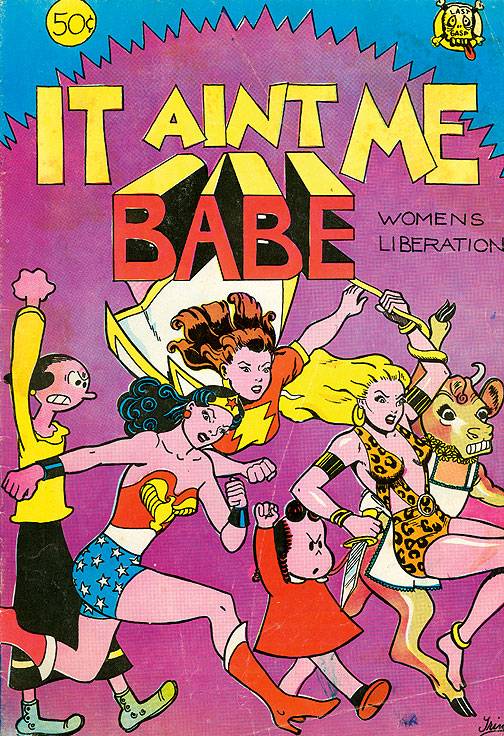Womens Liberation Changed Medicine: Difference between revisions
(inserted ten years tour icon) |
(fixed audio link) |
||
| Line 5: | Line 5: | ||
[[Image:14.gif|64px|left]] '''Listen to an excerpt from "Making Sexism Visible: Private Troubles Made Public" read by author Deborah Gerson:''' | [[Image:14.gif|64px|left]] '''Listen to an excerpt from "Making Sexism Visible: Private Troubles Made Public" read by author Deborah Gerson:''' | ||
< | <iframe src="https://archive.org/embed/14TenYears--womensHealthCareChangesMedicine" width="500" height="30" frameborder="0" webkitallowfullscreen="true" mozallowfullscreen="true" allowfullscreen></iframe> | ||
by [http://www.archive.org/download/14TenYears--womensHealthCareChangesMedicine/14DeborahGersonSfGeneralMastered2.mp3 mp3]. | by [http://www.archive.org/download/14TenYears--womensHealthCareChangesMedicine/14DeborahGersonSfGeneralMastered2.mp3 mp3]. | ||
Latest revision as of 10:46, 5 February 2014
Historical Essay
by Deborah Gerson
Listen to an excerpt from "Making Sexism Visible: Private Troubles Made Public" read by author Deborah Gerson:
<iframe src="https://archive.org/embed/14TenYears--womensHealthCareChangesMedicine" width="500" height="30" frameborder="0" webkitallowfullscreen="true" mozallowfullscreen="true" allowfullscreen></iframe>
by mp3.
![]()
Previous stop: The Mission mobilizes
Next Stop #15: Third worldism in SF
The first photograph on the first page in the very first movement-published issue of Our Bodies Ourselves shows women sitting on the floor in a circle, in a consciousness-raising group. Sitting and talking to each other women told the secrets of their bodies: How we felt about our flesh, our sex, our faces, our muscles, our minds; how we were too short, too tall, too fat, too loud, too desiring, too cold—our secrets were exposed. What seemed shameful, weird, pathological, ugly, or unacceptable was examined, reframed, and transformed.
As women met and talked in consciousness-raising groups, much of what we changed was our embodied selves. Women had sex differently, with different partners: we began to dress differently rejecting dresses and pantyhose. Women looked at their vulvas and cervix, examined their breasts. Others took up sports and recreational activities on their own. How women lived in their bodies, as much as how we thought about and felt about our bodies, radically changed.
Were women’s liberationists bra burners? The historical record reveals that the women demonstrating against the Miss America pageant in 1968 did not actually burn bras, but they did throw them into a trash can. While many women would continue to wear bras, what was burned was not the literal bra but the social bra, the political bra, the brassiere as symbol and practice of the exploited breast, the controlled breast, the subordinated, domesticated, playboy breast, the imperfect if not perfect breast, the man’s breast. In 1969, New England Free Press published “The Myth of the Vaginal Orgasm” on orange paper (four pages, 5 cents a copy); $1.00 got you twenty copies. Passed hand-to-hand, it became a quick organizing tool.10 In December 1970, the same press printed 5,000 copies of Our Bodies Ourselves; by the end of 1971, another 60,000 copies were in circulation. But San Francisco women did not, indeed could not, depend on the Boston Women’s Health Book Collective for direction or organization.
One of many underground feminist publications from the 1970s.
Courtesy Deborah Gerson
Knoop was already a member of the Gallstones when she and Geri Robertson traveled to Los Angeles and returned with a bag full of plastic speculums. She recalled her excitement, “They were doing this thing called ‘self-exam’…We spent three or four days down there and our minds were just blown by it. It was another way to empower ourselves, that you could know your own body in that way.” Knoop organized a group of women to learn self-health, and eventually form a walk-in storefront women’s health collective. The 24th Street Health Collective became a repository of education and information but rejected the idea of attempting to provide direct service. Young women learned about methods and problems with birth control, about pelvic exams and infections. Pregnant women learned about bodily changes, what they should know, look for, and ask for from medical providers. Older women, who became involved through viewing the film Self Health by Allie Light, were incorporated into the work of the collective. Beverly Rutzick recalled, “I was fifty, thirty years older than them… Verna [Pedrin] was already in the health center… and the two of us got together and decided there had to be some kind of program for older women [on] menopause.” Rutzick and Pedrin organized women, listened to women in workshops, and “developed a program. We gave workshops from menopause to midlife. We were kind of local experts for a while.”
Dress, clothing, body stance, decorum, what sociologists call “the presentation of self,” were contested in multiple spheres. Nursing students (at that time still overwhelmingly female) began rejecting the nursing cap, the white clothes. Knoop addressed her nursing school instructors “I will not wear white…I won’t wear a hat…are the two men in our group wearing hats? You know these are signs of subservience…and really, a nurse’s uniform is a maid’s uniform.”
Laurie Cahn recalled that her women’s group started as a self-help group where women learned to do self-exam and educate themselves about their own bodies, but moved on to consciousness-raising, mutual support and political action. “After six months (of self-exam)…we were really sick of this. Then we told each other our sexual histories, and from there…we met for the next six years.” For Cahn, now a martial arts teacher, the changed sensibility about her body, combined with her anti-war politics led her to pursue a martial arts class. Seeing pictures of “Vietnamese women carrying guns” and hearing about a Gung Fu class led her to Project Artaud. “There were two women in the class doing push-ups on their fingers. People were punching and kicking…I just thought WOW, that’s like the coolest thing I have ever seen. I want to do it; I want to be good at it. And I signed right up and here I am, 24 years later, still doing it.”
by Deborah Gerson, from her essay "Making Sexism Visible: Private Troubles Made Public," in the anthology "Ten Years That Shook the City: San Francisco 1968-78" (City Lights Foundation: 2011), edited by Chris Carlsson.
 Find the book at City Lights!
Find the book at City Lights!


